Each year over 290 million tires are discarded in the U.S. alone and disposing of all those old tires can be a big challenge for a lot of reasons. When used tires are sent to the landfill they cause numerous problems for both the landfill operators and the environment. Intact tires in a landfill tend to float to the surface of the trash heap where they make perfect homes for rodents and damage landfill liners, which can lead to even more environmental problems. And it’s not like those tires are going to disappear over time. On average, it takes a used tire around 50-80 years to decompose! For all these reasons, more and more states are requiring tires to be crushed before being sent to the landfill and in some cases, they’re banning them altogether.
See The Life of a Recycled Tire Infographic
It’s no secret to anyone that Americans adore their cars – and we have an awful lot of them! With two car families being the norm in the U. S., there are a whole lot of vehicles on the road. Our dependence on the automobile (and the infrastructure we have built to support it) has given us enormous freedom and unparalleled convenience. It’s also given us a lot of old tires to deal with!
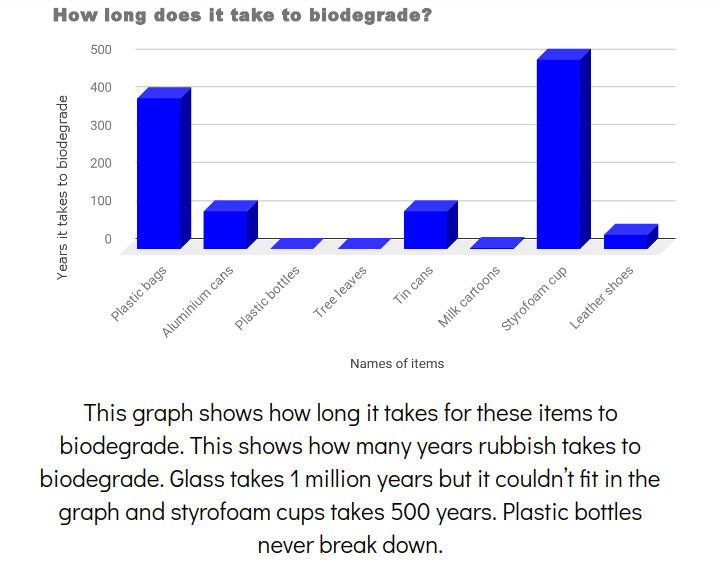
So what should we do with all those old tires? The good news is that we’ve found some really great solutions! Recycling is becoming an increasingly popular way to deal with the many millions of tires that are discarded in the U.S. each year. And it’s not just about keeping the tires out of the landfill. Ground up rubber is a fabulous option for a lot of different applications. Its durability and softness make it an ideal material to use as an additive in flooring, tracks, and roadways and it has even made its way to the stalls of many a fancy horse barn. The uses for used rubber are numerous, which is a good thing because there’s a lot of old rubber out there that needs to be used.
Its durability and softness make it an ideal material to use as an additive in flooring, tracks, and roadways and it has even made its way to the stalls of many a fancy horse barn. The uses for used rubber are numerous, which is a good thing because there’s a lot of old rubber out there that needs to be used.
One of the best ways to use discarded tires is to turn them into rubber mulch. Converting tires to mulch is a fairly simple process with long-lasting positive results. Rubber mulch can serve a lot of the same purposes as regular wood mulch but it has the added benefits of longer lasting durability, increased softness, and a weight that keeps it from blowing or floating away. While it costs a little more up front than wood mulch, it is an investment that will pay for itself over time. Gardeners love not having to re-mulch their flower beds every year and parents love the added security of knowing that if their child takes a tumble from the playground equipment they will most likely come out unscathed.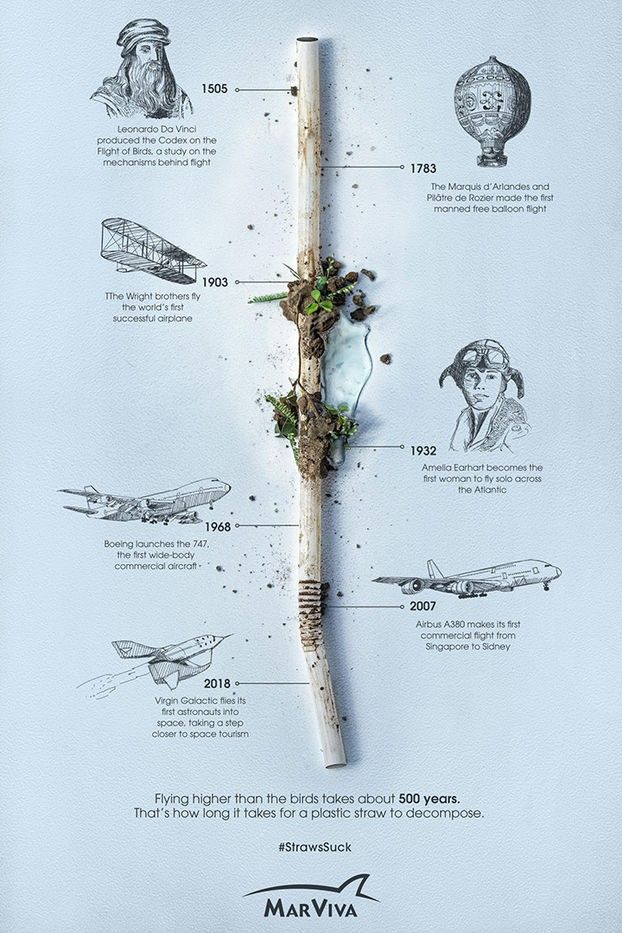
Step 1: Tire are gathered from landfills and drop off centers and taken to a processing facility.
Step 2: Sidewalls are cut out to remove metal and other debris from the rubber.
Step 3: Ground up tire pieces are heated and treated with softening agents to make them soft and pliable. This process is called vulcanization.
Step 4: The pieces are passed under a powerful magnet to remove any remaining metal while a vacuum sucks out any lingering polyester so that all you’re left with is clean, soft rubber.
Step 5: The pieces are cooled and painted.
Step 6: Rubber mulch is packaged up and sent back out into the marketplace
 Because it does not break down or fade, rubber mulch has a much longer lifespan than wood mulch. Rubber mulch won’t decompose like wood mulch and should hold its color for more than ten years.
Because it does not break down or fade, rubber mulch has a much longer lifespan than wood mulch. Rubber mulch won’t decompose like wood mulch and should hold its color for more than ten years.While no process or solution is perfect, creating new rubber products from spent tires takes a lot of the bite out of our used tire problem. Hopefully, as more uses for used rubber emerge, even fewer tires will make their way to the great trash heap in the sky. Until then, you can do your part to keep tires from the landfills by purchasing rubber mulch and other products made from recycled rubber!
Hopefully, as more uses for used rubber emerge, even fewer tires will make their way to the great trash heap in the sky. Until then, you can do your part to keep tires from the landfills by purchasing rubber mulch and other products made from recycled rubber!
Leo Shapiro
Published 8 years ago
Last updated 2 days ago
7562
4
min read
How long it takes 50 common items to decompose
The phrase “ashes to ashes, dust to dust” comes from a common English Christian burial rite that includes the following King James Bible quote: “In the sweat of thy face shalt thou eat bread, till thou return unto the ground; for out of it wast thou taken: for dust thou art, and unto dust shalt thou return.”
That’s a fancy way of saying that at some point we—like everything else on Earth—will eventually decompose. The word decompose means “to separate into constituent parts or elements or into simpler compounds,” according to Merriam-Webster. Biodegradation is a similar process, but one that is defined by elements that can be broken down into innocuous parts by the action of living things like worms or microorganisms.
Biodegradation is a similar process, but one that is defined by elements that can be broken down into innocuous parts by the action of living things like worms or microorganisms.
All non-living things are eventually broken down into simple molecules by the elements, microorganisms, and the ravages of time, but some things take significantly longer to decompose than others. When a person throws something in the garbage, the discarded item seems to be out of their life forever. However, the item’s journey to elemental breakdown or decomposition has just begun. Organic materials, like that leftover salad someone couldn’t quite finish, can return to the earth in a matter of days—but the plastic the salad was packaged in can stay put for thousands of years.
It’s important to note that many variables affect decomposition, and the timelines stated in this article are derived from averages or amalgamations based on large samples. Decomposition rates can vary dramatically based on factors like temperature, moisture, exposure to sunlight and the elements, the presence or lack of microorganisms, and whether the object is buried or exposed. Also, some items like plastic bottles contain a variety of objects that are made differently from various quantities of dissimilar materials. In other words, not all plastic bottles are the same, so they’re likely to have varied decomposition rates.
Also, some items like plastic bottles contain a variety of objects that are made differently from various quantities of dissimilar materials. In other words, not all plastic bottles are the same, so they’re likely to have varied decomposition rates.
While decomposition rates are inherently inexact, it is a topic worth discussing considering 8 million tons of plastic trash are dumped into the ocean every single year. In a world overflowing with discarded things, it’s important to know how long trash will hang around.
Stacker looked at how long it takes for the things people throw away to decompose. Continue reading on to find out for yourself below.
You may also like: Eco-friendly replacements for 50 plastic items in your life
1 / 50
Cigarette butts: 18 months to 10 years
Cigarette butts just might be the most common litter on planet Earth. Smokers consume about 5.5 trillion cigarettes every year, and a huge percentage of them wind up flicked out of car windows or dropped on the street where they wash into storm drains and eventually into the ocean or other waterways.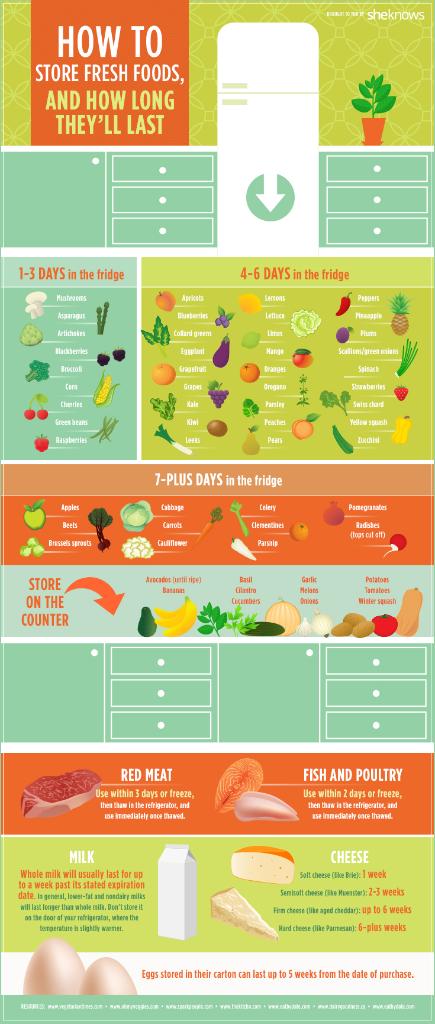 Cigarette filters contain slowly degrading plastic cellulose acetate, and butts are believed to represent a third of all litter in America; they are the most common litter found on America’s beaches.
Cigarette filters contain slowly degrading plastic cellulose acetate, and butts are believed to represent a third of all litter in America; they are the most common litter found on America’s beaches.
2 / 50
Monofilament fishing line: 600 years
According to the South Carolina Department of Natural Resources, monofilament fishing lines are especially hazardous because they ensnare and trap marine animals and other wildlife during their long, slow road to decomposition. Although monofilament fishing lines can be partially recovered and reused, the process for doing so isn’t widely used.
3 / 50
Gansstock // Shutterstock
Plastic bags: 10–1,000 years
Consumers in recent years have become more aware of the environmental hazard posed by plastic bags, but plastic bags are still one of the most common pollutants. Although they can break down in as little as a decade, the commonly discarded thin plastic bags can endure for as long as 1,000 years.
4 / 50
JBFhoto // Shutterstock
Foamed plastic cups: 50 years
Foamed plastic cups decompose faster than most plastic waste. Even so, these plastic cups can be expected to endure for half a century before they finally break down and rejoin nature.
5 / 50
Straws: 200 years
Since they are essentially unnecessary (for most people) and almost never make it into the recycling bin, plastic straws have become a top target of environmentalists hoping to reduce plastic waste. Americans use millions of straws a day, which can remain on the earth for two centuries after being tossed in the garbage.
6 / 50
siam.pukkato // Shutterstock
Wet wipes: 100 years
Wet wipes are popular for quickly removing makeup, changing babies’ diapers, and making house cleaning a snap. The problem is they contain polyester-based plastic that’s virtually indestructible; they take a century to break down after they’re tossed in the garbage or flushed down the toilet.
7 / 50
Tom Grundy // Shutterstock
6-pack holders: 450 years
Even when the circles on plastic six-pack holders are cut, they still pose a major threat to wildlife, as they often wind up in the ocean. The thin plastic can holders take nearly half a millennium to break down.
8 / 50
Tin: 50 years
Tin can take half a century to break down in a landfill, according to Electronics Recyclers International. Tin is used to make food cans, but it’s also a common component of computers and other electronics.
9 / 50
Tires: 2,000 years
The South Carolina Department of Natural Resources estimates that tires can take two millennia to revert back to nature. They’re also laden with heavy metals like lead, oils, and other pollutants that contaminate the environment as they break down. About 242 million tires are discarded every year in the U.S. alone, and only 7% are recycled.
10 / 50
Nylon fishing nets: 40 years
Nylon fishing nets can be reused, but they can’t be fully recycled.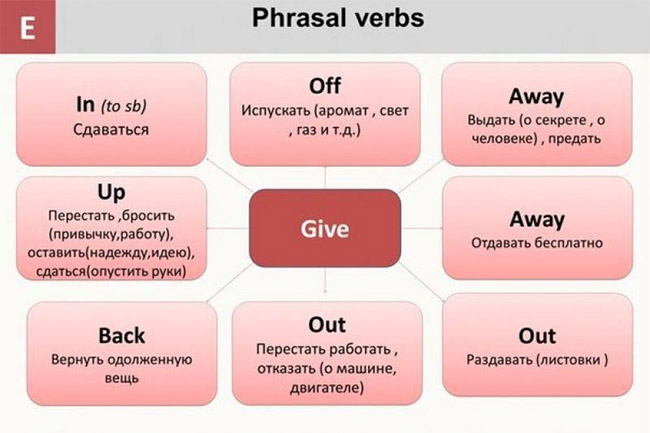 When they’re lost or intentionally cut, they present a major hazard to marine animals and other wildlife that become entangled in them both in the water and on the shores.
When they’re lost or intentionally cut, they present a major hazard to marine animals and other wildlife that become entangled in them both in the water and on the shores.
11 / 50
Take Photo // Shutterstock
Nylon fabric: 30–40 years
Nylon fabric is often used for sports equipment like jerseys and mesh shorts, but it’s also found in arts and crafts supplies. Frequently trashed, the material takes decades to decompose.
12 / 50
Teerasak Ladnongkhun // Shutterstock
Plastic bottles: 450 years
Pollution from plastic bottles is a global problem, but in the United States alone more than 60 million bottles are thrown away instead of being recycled every single day. They wind up in landfills, incinerators, oceans, parks, streets, and other public spaces. One of the easiest items to recycle, plastic bottles take hundreds of years to decompose.
13 / 50
SQS // Shutterstock
Cotton T-shirts: 6 months
T-shirts are one of the most common items in the so-called fashion waste category of pollution, which accumulates when people throw old clothes away instead of donating them, swapping them, or recycling them. The common cotton T-shirt can decompose in six months.
The common cotton T-shirt can decompose in six months.
14 / 50
Wool socks: 1–5 years
Like T-shirts, old wool socks are often presumed to be un-donatable and are therefore tossed in the garbage. Unlike cotton T-shirts, they linger in landfills for up to five years.
15 / 50
Synthetic fabric: over 100 years
Unlike naturally occurring wool and cotton, synthetic fabrics like lycra and polyester can take centuries to break down. The vast majority of fashion waste can be donated or repurposed into things like dog beds or cleaning rags instead of being thrown in the garbage.
16 / 50
Aluminum cans: 80–100 years
Aluminum cans only start to break down after 80 to 100 years and will only fully decompose after several centuries. Unlike many other materials, aluminum can be recycled an unlimited number of times, making it one of the most critical and widely repurposed recyclables.
17 / 50
Vegetables: 5 days to 1 month
Vegetable matter breaks down quickly, and in some cases, in less than a week. This, along with the excellent nutrient content contained within decaying vegetable matter, makes veggie scraps perfect for composting.
This, along with the excellent nutrient content contained within decaying vegetable matter, makes veggie scraps perfect for composting.
18 / 50
Orange peels: 6 months
Fruits can take longer than vegetables to break down, particularly those that are highly acidic. Self-contained and easy to eat on the go, oranges account for more scrap waste than most fruits, and they also take longer to decompose.
19 / 50
Banana peels: up to 6 months
Billions of bananas are consumed every year, and like oranges, their peels don’t decompose for several months. Also like oranges, banana peels are perfect for composting or tossing in the garden.
20 / 50
Hairspray bottles: 200–500 years
Aerosol bottles like the kind that contain hairspray are a common sight in landfills across the world. A single one can remain intact for the entire duration of the Roman Empire before it decomposes.
21 / 50
Rope: 3–14 months
Common rope can take a little more than a year or a single season to decompose, depending on the materials used to make it. Natural materials like hemp decompose faster than synthetic materials like the kind used to produce climbing rope.
Natural materials like hemp decompose faster than synthetic materials like the kind used to produce climbing rope.
22 / 50
Lex Collection // Shutterstock
Sanitary pads and tampons: over 25 years
About 7 billion tampons and 12 billion sanitary pads are thrown away every year in the United States alone, most of which contain plastic in the lining or the applicator. The cotton portion decomposes fairly quickly, but the low-density polyethylene plastic takes decades to break down. Never flush plastic applicators, as they can end up in the ocean.
23 / 50
karina // Shutterstock
Cotton gloves: 3 months
Common cotton gloves can break down in as little as three months. However, that rate is contingent on the gloves being 100% cotton. The biodegradation rate increases dramatically with the inclusion of synthetics like those used for waterproofing and insulation.
24 / 50
Malochka Mikalai // Shutterstock
Latex gloves: several months to several years
Latex gloves break down fairly quickly, provided they’re made from natural latex rubber.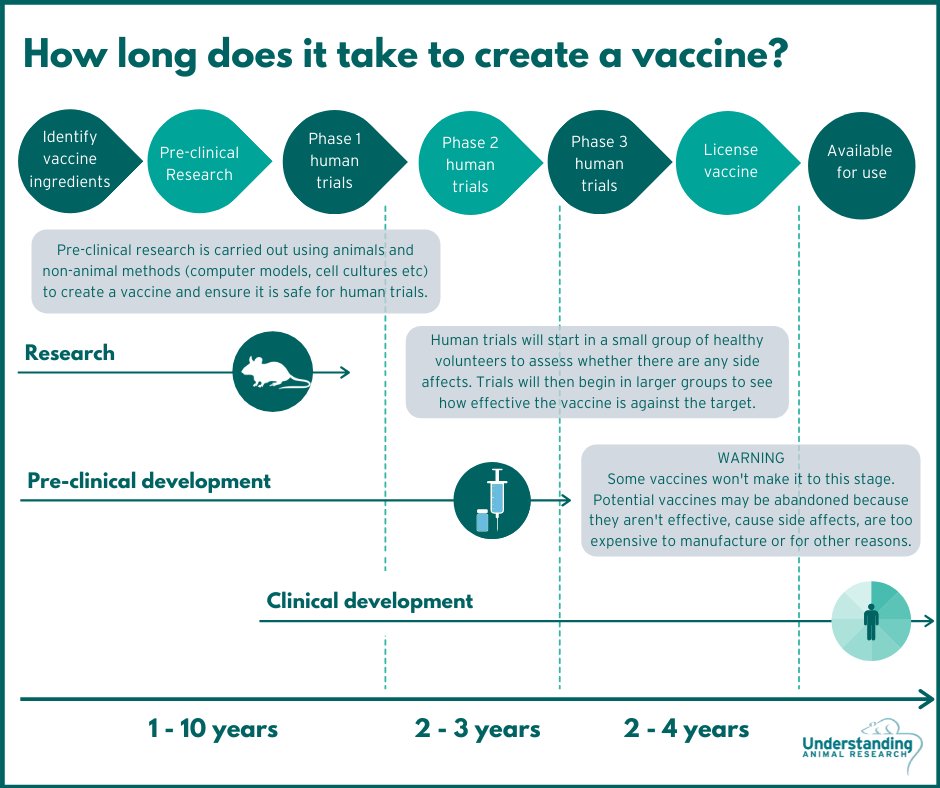 Like all synthetic rubber, synthesized latex can take years, decades, or longer to decompose.
Like all synthetic rubber, synthesized latex can take years, decades, or longer to decompose.
25 / 50
Thread: 3–4 months
From furniture to clothing and car interiors to suitcases, threads are everywhere—including in the world’s landfills. Thread is thin and light, but it piles up fast; it also decomposes relatively quickly.
26 / 50
Paper waste: 2–6 weeks
Paper waste takes only about a month—or a few weeks, give or take—to break down in landfills, but the problem is volume and quantity. Even though it’s one of the most commonly recycled materials, paper waste takes up more space in landfills than any other product.
27 / 50
Iron: several years
All metal breaks down differently, but iron oxidizes at a fairly rapid rate. People know oxidation as rust—the brown, flaky stuff that’s often mistakenly blamed for tetanus infections. Over the course of several years, iron will oxidize completely, particularly in coastal areas that are damp and coated with salt water residue.
28 / 50
Food waste: several months to several years
Americans waste 40% of all the food they purchase every year—a full 35 million tons worth $165 billion. Depending on how it’s disposed, and what it contains, food waste can break down in a few months or remain in a state of partial preservation for years.
29 / 50
Shoes: 25–40 years
Leather shoes take a quarter-century or more to decompose. Like virtually all wearable leather products, shoes contain chemicals, dyes, and additives that can leach into the water and soil as the leather breaks down.
30 / 50
Rubber boot soles: 50–80 years
Unlike the shoe itself, rubber soles, particularly those fixed to the bottom of heavy boots, can take more than half a century to decompose. Except for a few environmentally conscious brands, virtually all shoe companies use slow-decaying synthetic rubber to make boot soles.
31 / 50
Cardboard: 2 months
Aside from recycling, cardboard can be composted, used as garden mulch, or repurposed creatively as craft material or pet bedding.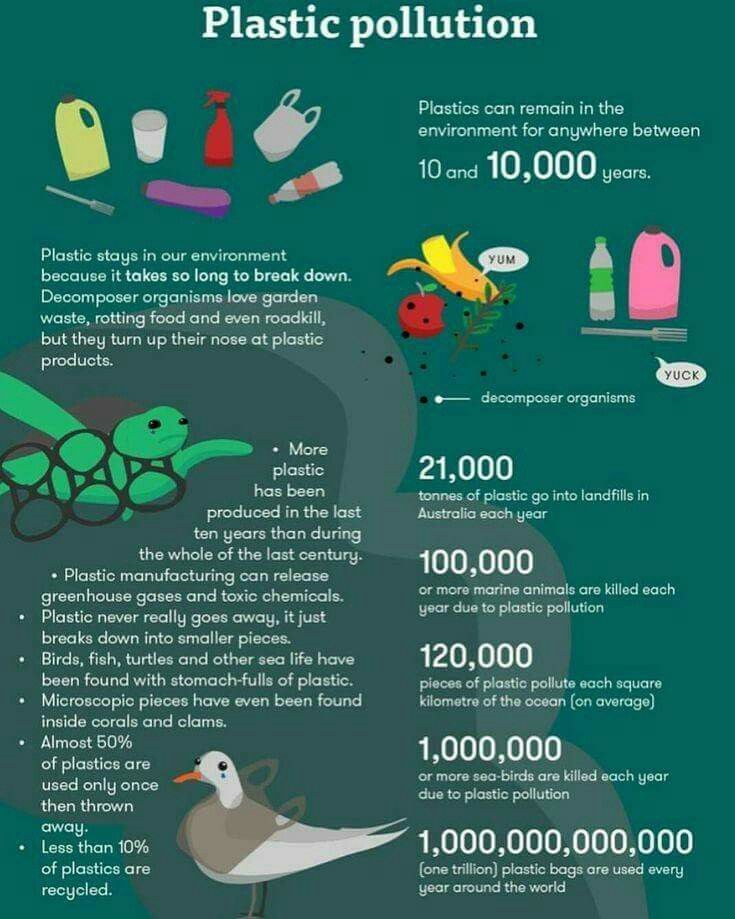 It breaks down fairly quickly when it’s exposed, but tightly packed cardboard can endure for years.
It breaks down fairly quickly when it’s exposed, but tightly packed cardboard can endure for years.
32 / 50
Train tickets: 2 weeks
Many paper train tickets are made from a coated material that contains more than just paper. Countless millions of train tickets are printed every year, and virtually all of them are thrown away. People can contribute to a cleaner planet by hanging onto their tickets and recycling them at home.
33 / 50
Canvas: 1 year
Highly durable and versatile, a plain-woven canvas is used to make everything from painting surfaces and handbags to clothing and sails. Assuming it’s not treated with chemicals, a canvas will break down in about a year, but heavy canvas decomposes slower than light canvas.
34 / 50
Paper towels: 2–4 weeks
In the U.S. alone, more than 13 billion pounds of paper towels are disposed of every year. Around 51,000 trees would be needed to replace the number of paper towels Americans burn through every single day. Switching to reusable cloth wipes will help lower that statistic.
Switching to reusable cloth wipes will help lower that statistic.
35 / 50
Waxed milk cartons: 3 months
Many recycling plants don’t accept paper/plastic hybrid cartons, resulting in millions of tons of packaging waste being dumped in landfills every year. Waxed cartons, used to hold liquids like milk, have a lower packaging-to-product ratio, so they decompose quicker than their non-waxed counterparts.
36 / 50
Aquarius Studio // Shutterstock
Non-waxed cartons: 5 years
Like their waxed counterparts, non-waxed cartons often wind up on the trash heap because consumers believe—correctly or incorrectly, depending on the municipality—that they can’t be recycled. Since they require more materials to produce, non-waxed cartons can linger for five years before they decompose.
37 / 50
Laboko // Shutterstock
Disposable diapers: 500 years
Disposable diapers can’t be recycled for obvious reasons, and the average baby goes through up to 10,000 of them before being potty trained. The #3 most common consumer item found in landfills, disposable diapers represent 30% of all non-biodegradable waste.
The #3 most common consumer item found in landfills, disposable diapers represent 30% of all non-biodegradable waste.
38 / 50
Rubber bands: up to 1 year
Once thrown away, the sulfur in rubber bands begins to decay, and the rubber bands themselves will begin to break down. They’ll generally be gone in a year, depending on the composition of the rubber, but rubber bands that are stretched break down much faster than those that are not.
39 / 50
Painted boards: 13 years
Painted boards, like the kind that get thrown away to replace a section of fence, can take more than a dozen years to decompose. The paint, however, can degrade much slower, leaching hazardous toxins into the environment.
40 / 50
Addoro // Shutterstock
Lumber: 10–15 years
Lumber is heavy and solid and can take more than a decade to break down. Some lumber, like the kind that is used for outdoor applications, is treated with chemicals, which can slow the process of decay and bleed chemicals into the earth.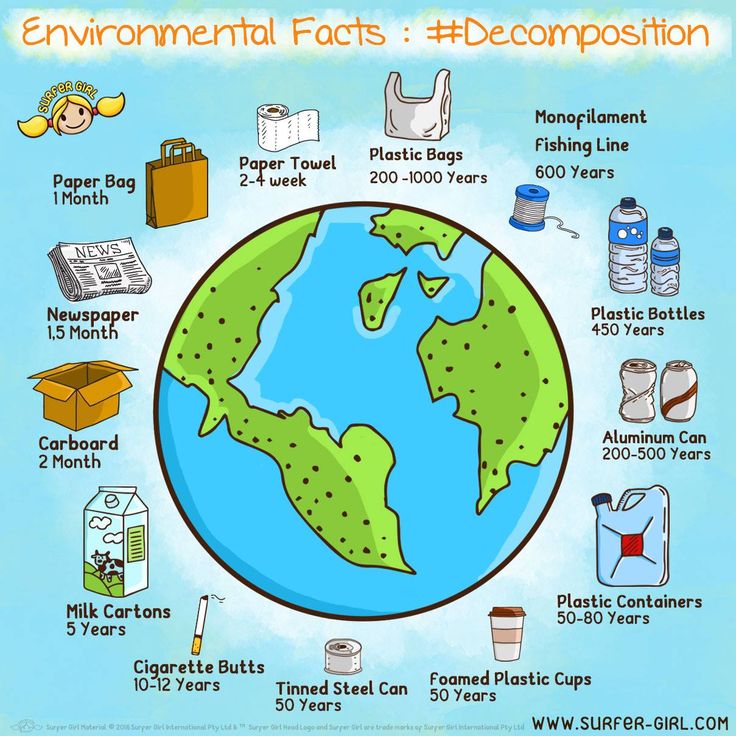
41 / 50
Yakov Oskanov // Shutterstock
Plywood: 1–3 years
Plywood breaks down much faster than solid lumber, but it’s not a completely natural process. Plywood contains glue that can decompose at a much slower rate than the wood plies it bonds together.
42 / 50
Batteries: 100 years
Common household alkaline batteries are safe to throw away. However, rechargeable batteries, car batteries, and other industrial types must be disposed of, according to federal guidelines.
43 / 50
Ink cartridges: 450–1,000 years
The ink cartridges from printers are a double-edged sword. Not only do they take centuries to decompose, but they also leak toxic chemicals as they break down. Most recycling plants won’t accept them, but major office-supply stores encourage customers to bring the empty ones back for proper disposal.
44 / 50
Leather: 50 years
Leather comes from animal hides, but it is not a natural product. The tanning process involves treating the hides with a soup of chemicals, particularly if the leather was designed to be water-resistant. That means leather leaches chemicals and other toxins into the earth as it breaks down over half a century.
The tanning process involves treating the hides with a soup of chemicals, particularly if the leather was designed to be water-resistant. That means leather leaches chemicals and other toxins into the earth as it breaks down over half a century.
45 / 50
Plastic bottle caps: 10–500 years
Bottle caps previously had to be separated from plastic bottles before they could be recycled, as caps and bottles are made from two different types of plastic. However, advancements in the industry mean that bottle caps can now be kept on for recycling. Bottle caps are made from high-density polyethylene and polypropylene, both of which can now be recycled.
46 / 50
Apple cores: 2 months
Apple cores don’t take quite as long as banana peels and oranges to decompose. However, they remain intact longer than fruits and vegetables that are denser and have higher water content. Once tossed into the garbage, an apple core takes about eight weeks to biodegrade.
47 / 50
Africa Studio // Shutterstock
Polyurethane seat cushions: 1,000 years
Polyurethane cushions, commonly found in car seats and home furniture, are made by injecting a foam mixture into molds. Once they hit the garbage heap, however, they remain as is for centuries.
48 / 50
xpixel // Shutterstock
Glass: over 1 million years
Since it breaks so easily, people tend to think of glass as fragile, but it’s actually one of the most durable materials on Earth, at least in terms of decomposition. Relics from the earliest days of glass-making in 2000 B.C. Egypt still exist, and experts theorize that a glass bottle would take 1 million years or more to fully decompose on its own.
49 / 50
Aluminum foil: never
Americans throw away enough aluminum foil every year to build a fleet of aircraft, and that’s a sad statistic for two reasons. First, aluminum foil is easily and completely recyclable. Secondly, these thin, foldable, metallic sheets never break down all the way to full decomposition.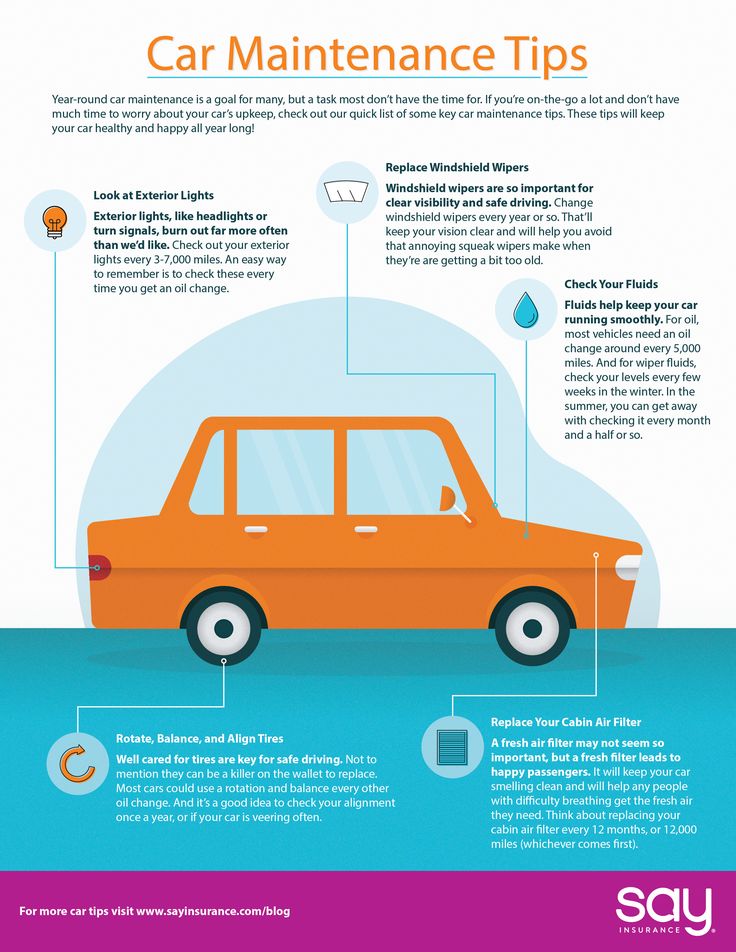
50 / 50
r.classen // Shutterstock
Styrofoam: never
In the world of landfill-clogging waste from America’s throwaway culture, there is Styrofoam and there’s everything else. More than 3 million tons of polystyrene products are produced in the U.S. every year, the vast majority of which are one-and-done, single-use throwaway products. Styrofoam is efficient and inexpensive, but making it requires the use of fossil fuels and dangerous chemicals. Virtually no communities allow it to be included in recycling. It is not biodegradable, so it never decomposes. Americans throw away 25 billion Styrofoam coffee cups alone every single year—enough to circle the earth 436 times.
Scientists have already proven that plastic bottles and bags can lie for hundreds, thousands and even millions of years and not decompose.
Here is a list of the things we throw away and how long it takes for this garbage to decompose.
2 weeks
Apple cores and other fruit leftovers.
Although this is a fairly short time to decompose, food leftovers on the ground can attract unwanted "friends" such as rats.
About 1 month
Paper napkins, paper bags, newspapers, paper towels.
The time it takes these things to decompose can vary greatly, as it depends on how you got rid of that type of trash.
6 weeks
Cereal boxes, paper bags, banana peels.
Banana peel may take longer to decompose if the weather is cooler. Since the peel is designed to keep the fruit fresh, it is high in cellulose, the same material that plastic bags are made from.
Some conservationists warn that the peel of some fruits, including banana peels, can take months to decompose. Even if the product is natural, this does not mean that it decomposes quickly.
From 2 to 3 months
Milk and juice cartons and other types of cardboard.
The decomposition time of the cardboard primarily depends on its thickness.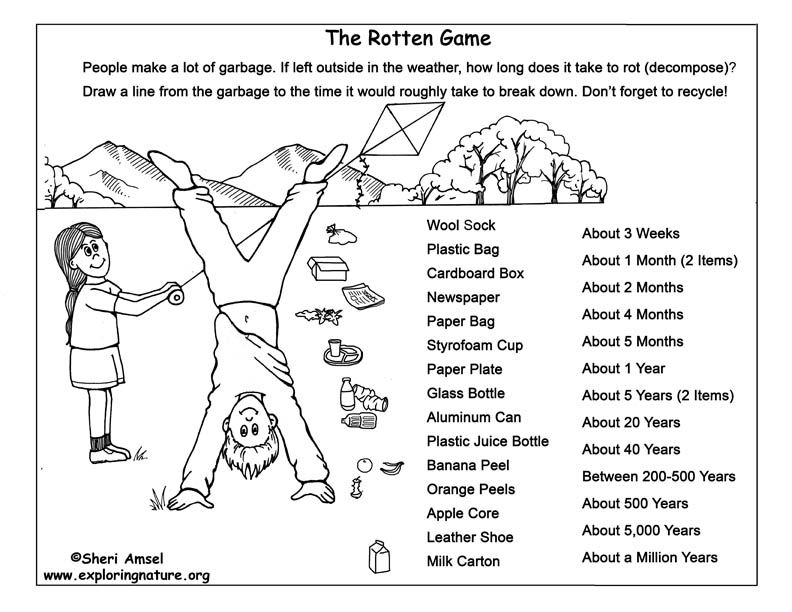 It is worth noting that some cartons may contain chemicals that significantly slow down the decomposition process.
It is worth noting that some cartons may contain chemicals that significantly slow down the decomposition process.
6 months
Cotton clothes and paper books.
Of all fabrics, cotton decomposes the fastest because it is natural. If the cotton fabric thrown into the landfill is quite thin, then in warm weather it can decompose in just a week.
1 year
Woolen clothes (sweaters, socks).
Wool is a natural product and can degrade relatively quickly. What's more, as wool decomposes, it releases soil-friendly elements such as keratins. This product cannot be called completely garbage, as it does not cause long-term harm to the environment.
2 years
Orange peel, plywood.
Up to 5 years
Heavy wool clothing such as a coat or overcoat.
Up to 20 years
Plastic bags. But studies show that in some cases, plastic bags can take up to 1,000 years to decompose.
Many new plastic bags are designed to degrade quickly when exposed to direct sunlight.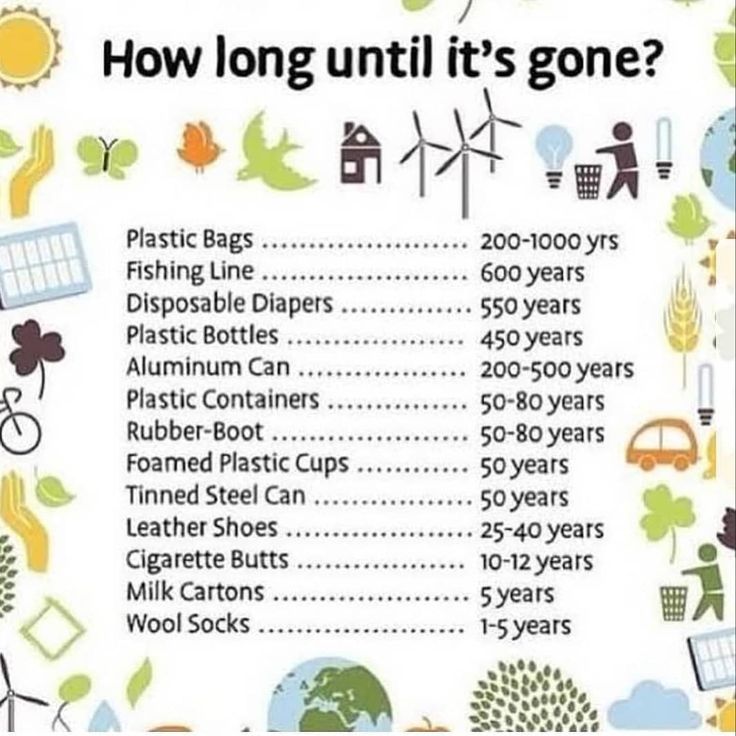
Yet most plastic bags are made from HDPE. Microorganisms in the ground do not perceive the chemicals that make up the bag as food, and therefore they do not participate in its decomposition.
30-40 years old
Goods containing nylon: leotards, windbreakers, carpets, diapers. Some scientists believe that such goods can take up to 500 years to decompose, depending on environmental conditions.
Although diapers are quite comfortable, they are also quite toxic, even if you haven't used them yet. They are processed with a variety of chemicals such as toluene, ethylbenzene, xylene, and dipentene, as well as a chemical called dioxin, which is a highly toxic carcinogen.
50 years old
Tin cans, car tires, Styrofoam cups, leather.
Leather may be chemically treated (as with fashion items) and may take much longer to decompose.
The thick leather used to make shoes can take up to 80 years to decompose.
From 70 to 80 years old
Rustling plastic bags (from chips and packaging, for example).
Despite the fact that a person eats the contents of a bag of chips very quickly, the bags themselves decompose for a long time. For example, one of the US residents found an empty bag of chips on the beach in Devon, dated 19'67, but the package itself looked like it had been thrown out last week.
About 100 years
Products made of polyethylene.
Of course, the decomposition time depends on the density and structure of the product. For example, ordinary plastic shopping bags can take up to 100 years to decompose.
Also in the category of things that can decompose for more than a century are plastic bottles and various plastic containers and bowls.
It is worth noting that small parts made of polyethylene can be dangerous for animals, who can choke on them.
About 200 years old
Aluminum cans (for beer or soda, for example).
In this case, too, everything depends on the density of the material and its structure. In the best case, such objects decompose for 200 years, but this process can drag on for half a millennium.
In the best case, such objects decompose for 200 years, but this process can drag on for half a millennium.
It is worth noting that, like polyethylene products, such items are dangerous for small animals that can climb into an empty jar and get stuck in it.
Such cans can be recycled many times and this process requires much less energy than creating a new can. Using the same amount of energy, you can make 20 recycled cans or 1 new aluminum can.
500 years
Plastic bottles.
In general, petrochemicals such as plastic bottles never completely decompose and the chemical elements simply remain in the ground.
1 to 2 million years
Glass jars and bottles
Goods made of glass can even be stored forever, because glass, created in lava flows millions of years ago, is still there.
Most glass is made of quartz, more specifically quartz sand (SiO2) - one of the most stable and durable minerals on our planet.
The only problem with glass is that it shatters, making the pieces dangerous to animals, who might mistake them for food.
Over 2 million years
Batteries
Although the thin metal shell of the batteries degrades relatively quickly, the toxic chemicals inside (zinc chloride, lead, mercury, cadmium) soak into the ground.
Therefore, batteries should not just be thrown away, but recycled.
I have long wanted to "launch" this topic on the blog. It concerns the problem of garbage and pollution of our planet. Well, who does not observe this terrible picture of pollution of cities and villages, especially in recent decades. Of course, it is connected with the activities of mankind and the development of production technologies. They have learned to produce, but not to destroy the waste of this production. This topic is especially relevant for the countries of the so-called third world and ... CIS countries.
It is sad and mournful to look at everything that is happening related to littering and pollution: how will future generations live on this planet, turned into a garbage dump?
As a result of the development of technologies in the field of consumption, the materials from which objects are made take a very long time to self-destruct (decompose) and there are more and more of them.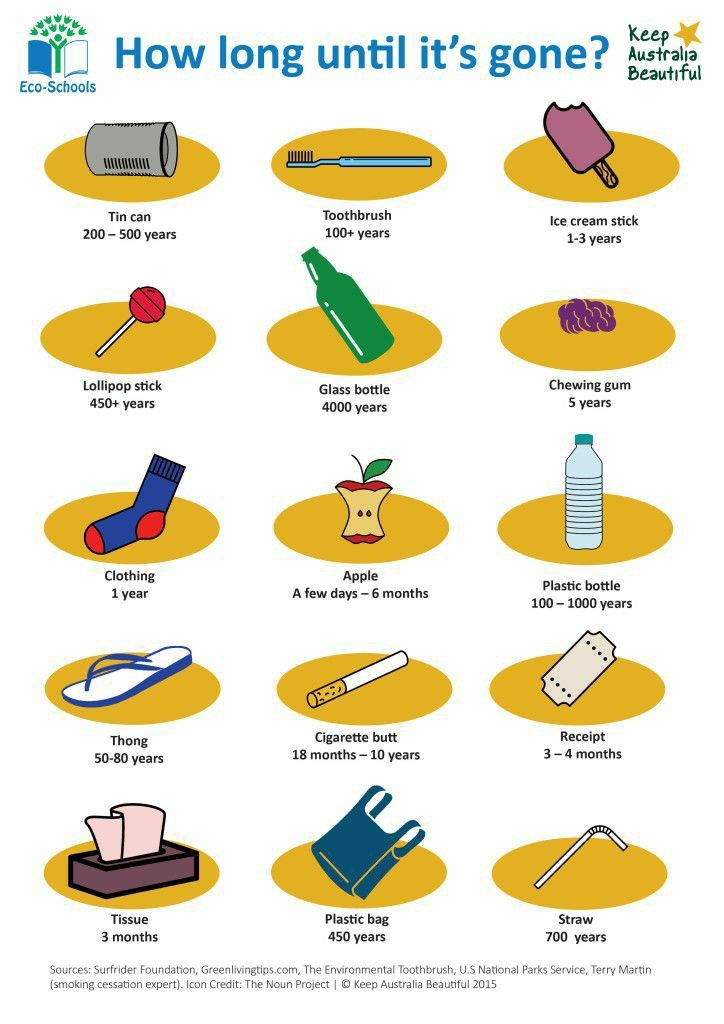 This has to be dealt with somehow. And immediately!
This has to be dealt with somehow. And immediately!
And now, for reference:
in increasing order, starting with examples where the product decomposes faster and ends with the longest self-destructing.
Simply put, litter from animals living in cities and in which people are somehow involved in life.
The period of "self-destruction" is not long - 10-15 days, but this does not beg the problematic issue. Why - it is clear without explanation :).
Decomposition time about a month. But the smell from decomposition products is usually very unpleasant.
Decomposes within one to three months. Depending on weather conditions and other environmental reasons. However, as for most other types of garbage.
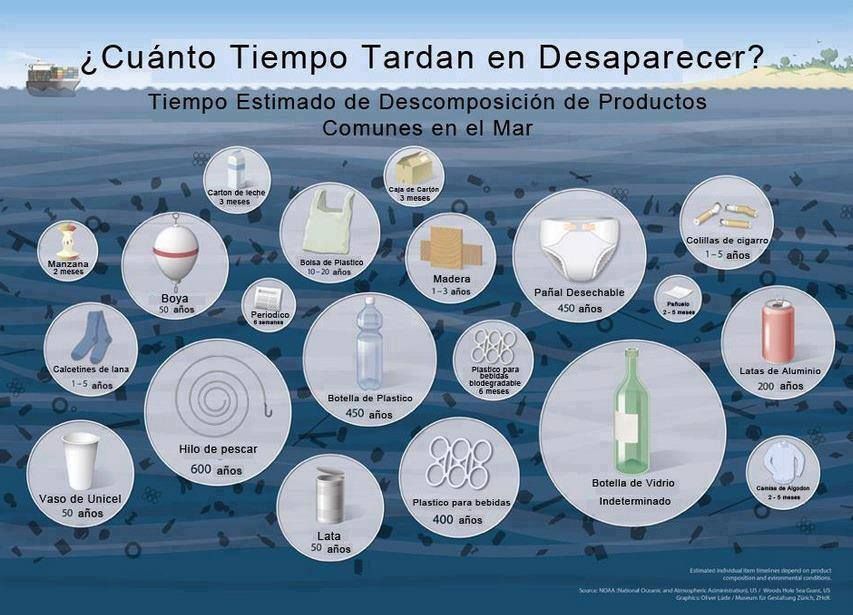 Leaves, twigs and seeds - "tree-handicraft garbage"
Leaves, twigs and seeds - "tree-handicraft garbage" rubbish, with which the janitors “work” and the participants of subbotniks actively fight 🙂
The decay period is three to four months.
Decomposes within three months. And even more.
Office ("writing") paper decomposes longer than newsprint and cardboard: two years.
Decomposition time up to ten years.
Under normal conditions, they decompose within ten years.
disposed of in a landfill breaks down in about 10 years.
Turn into iron oxide (i.e. decompose) in 10-20 years. Depending on the invoice.
Destroyed in about 100 years.
And it will take more than 100 years to decay…
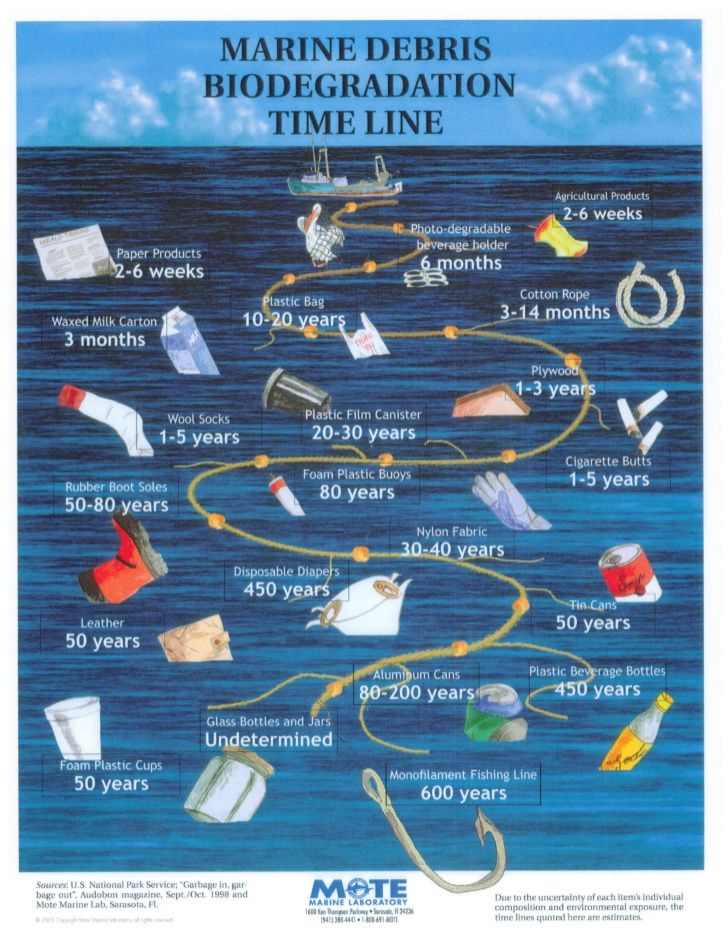 Electric batteries
Electric batteries
“Live” before decomposition, for some reason, longer than batteries - about 110 years.
May only decompose within 120-140 years.
This product of the creation of mankind and its high technologies, which has been very widespread over the past 30 years, brings many benefits. But alas, such bottles decompose for a very long time: as many as 200 years !
A terrible thing, I tell you. Aluminum decomposes within 500 years . It is understandable - non-ferrous metal. Yes, that's just in vain they began to use it for domestic purposes, probably. It’s good that homeless people collect them and hand them over to scrap metal collection points.
Oh, this is glass… A product that mankind invented long ago and it makes no sense to talk about its benefits and significance for people. One thing is unpleasant: of all the products created using the technology of processing silicon into this transparent liquid and solid under normal conditions, it is very difficult to “evaporate”. Glass breaks longer than any other household product - over 1000 years ! Citizens, do not scatter glass in places where people and other fauna and flora live! Take care of nature and our Planet!
One thing is unpleasant: of all the products created using the technology of processing silicon into this transparent liquid and solid under normal conditions, it is very difficult to “evaporate”. Glass breaks longer than any other household product - over 1000 years ! Citizens, do not scatter glass in places where people and other fauna and flora live! Take care of nature and our Planet!
Every day we see abandoned bottles, leftover food, plastic bags, paper and plastic cups and other garbage on the roads, sidewalks, yards and parks that were simply left on the street.
Sometimes it seems to us that in another day it will be removed, and it will begin to decompose in a landfill. But, firstly, not everywhere the garbage is removed in a timely manner, and secondly, some garbage can decompose for thousands of years.
How many years does garbage decompose
Scientists have already proven that plastic bottles and bags can lie for hundreds, thousands and even millions of years without decomposing.
Here is a list of the things we throw away and how long it takes for this garbage to decompose.
Paper and food waste
2 weeks
Apple cores and other fruit residues.
Although this is a fairly short time to decompose, leftover food on the ground can attract unwanted "friends" such as rats.
About 1 month
Paper napkins, paper bags, newspapers, paper towels.
The time it takes these things to decompose can vary greatly as it depends on how you got rid of that type of trash.
6 weeks
Cereal boxes, paper bags, banana peels.
Banana peel may take longer to decompose if the weather is cooler. Since the peel is designed to keep the fruit fresh, it is high in cellulose, the same material that plastic bags are made from.
Some conservationists warn that the peel of some fruits, including banana peels, can take months to decompose. Even if the product is natural, this does not mean that it decomposes quickly.
Even if the product is natural, this does not mean that it decomposes quickly.
2 to 3 months
Milk and juice cartons and other types of cardboard.
The decomposition time of the cardboard primarily depends on its thickness. It is worth noting that some cartons may contain chemicals that significantly slow down the decomposition process.
6 months
Cotton clothes and paper books.
Of all fabrics, cotton decomposes the fastest because it is natural. If the cotton fabric thrown into the landfill is quite thin, then in warm weather it can decompose in just a week.
1 year
Woolen clothing (sweaters, socks).
Wool is a natural product and can degrade relatively quickly. What's more, as wool decomposes, it releases soil-friendly elements such as keratins. This product cannot be called completely garbage, as it does not cause long-term harm to the environment.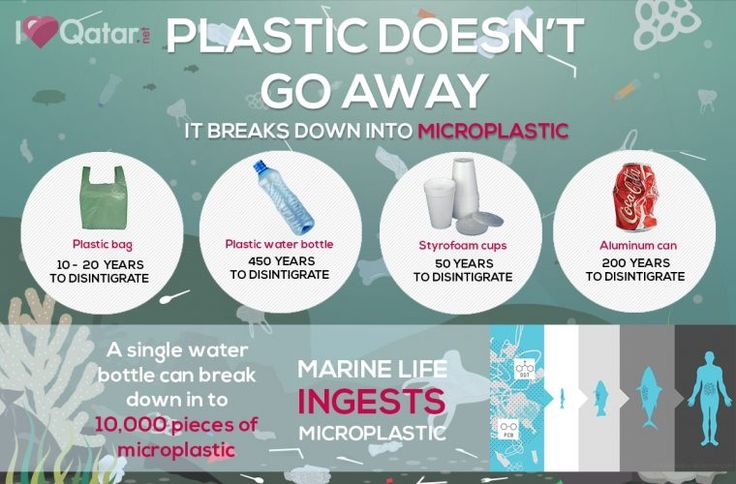
2 years
Orange peel, plywood, cigarette butts (although some studies indicate that cigarette butts may take more than 10 years to decompose).
Up to 5 years
Heavy wool clothing such as a coat or overcoat.
Plastic trash
Up to 20 years
Plastic bags. But studies show that in some cases, plastic bags can take up to 1,000 years to decompose.
Many new plastic bags are designed to degrade quickly when exposed to direct sunlight.
Yet most plastic bags are made from HDPE. Microorganisms in the ground do not perceive the chemicals that make up the bag as food, and therefore they do not participate in its decomposition.
30-40 years
Articles containing nylon: leotards, windbreakers, carpets, diapers. Some scientists believe that such goods can take up to 500 years to decompose, depending on environmental conditions.
Although diapers are quite comfortable, they are also quite toxic, even if you haven't used them yet.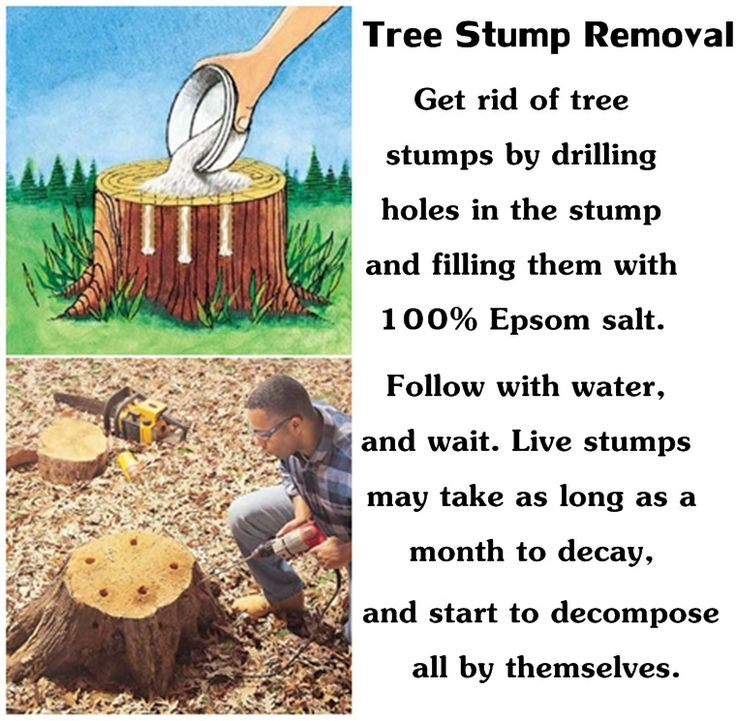 They are processed with a variety of chemicals such as toluene, ethylbenzene, xylene, and dipentene, as well as a chemical called dioxin, which is a highly toxic carcinogen.
They are processed with a variety of chemicals such as toluene, ethylbenzene, xylene, and dipentene, as well as a chemical called dioxin, which is a highly toxic carcinogen.
Metal waste, rubber, leather
50 years
Cans, car tires, Styrofoam cups, leather.
Leather can be chemically treated (as with fashion items) and take much longer to decompose.
The thick leather used to make shoes can take up to 80 years to decompose.
Polyethylene degradation
70 to 80 years
Rustling plastic bags (from chips and packaging, for example).
Despite the fact that a person eats the contents of a bag of chips very quickly, the bags themselves decompose for a long time. For example, one US resident found an empty bag of crisps on a Devon beach, dated 1967, but the bag itself looked like it had been thrown away last week.
About 100 years
Products made of polyethylene.
Of course, the decomposition time depends on the density and structure of the product. For example, ordinary plastic shopping bags can take up to 100 years to decompose.
Also in the category of things that can decompose for more than a century are plastic bottles and various plastic containers and bowls.
It is worth noting that small parts made of polyethylene can be dangerous for animals, who can choke on them.
Aluminum decomposition
About 200 years
Aluminum cans (for beer or soda, for example).
In this case, too, everything depends on the density of the material and its structure. In the best case, such objects decompose for 200 years, but this process can drag on for half a millennium.
It is worth noting that, like plastic products, such items are dangerous for small animals that can climb into an empty jar and get stuck in it.
Such cans can be recycled many times and this process requires much less energy than creating a new can. Using the same amount of energy, you can make 20 recycled cans or 1 new aluminum can.
Using the same amount of energy, you can make 20 recycled cans or 1 new aluminum can.
Recycling aluminum cans
Plastic decomposition
Dear readers, today the main topic of our article has become! Did you know that the decomposition time of various materials under natural conditions:
Cotton - 1-5 months .
Paper - 2-5 months .
Plastic bag - approx. 400 years old
Plastic container, packaging - non-degradable
*about 400 years old - the time of decomposition of one plastic bag in nature
* 20 minutes is the average use time for one plastic bag
* 60% plastic bags do not decompose and do not burn
* 60% Seabed Polluting Waste - Plastic Bags
* Approximately 6 million 300 thousand tons of garbage, most of which is plastic, is dumped into the world's oceans every year. The ecology of the planet is greatly disturbed due to plastic waste.
* According to the United Nations Committee for Nature Conservation, plastic waste kills 1 million birds, 100,000 marine mammals and countless fish every year.
* Less than 1% of plastic has ever been recycled.
* The term of the final decomposition of polyethylene is about 500 years. And when burned, they emit harmful substances that are dangerous to nature and human health.
And most importantly:
Almost every piece of plastic EVER made still exists.
Polyethylene packaging has a very short lifespan and goes to landfill very quickly. Getting rid of used plastic is almost impossible. Until recently, there were only two ways to solve the problem: burying and burning plastic waste. But plastic does not decompose in the soil, and when it is burned, substances that are extremely toxic to humans are released. Penetrating into the soil, the "poison" enters the groundwater, and then into the water supply.
Now let's think! For example, we visit the store 1-3 times a week.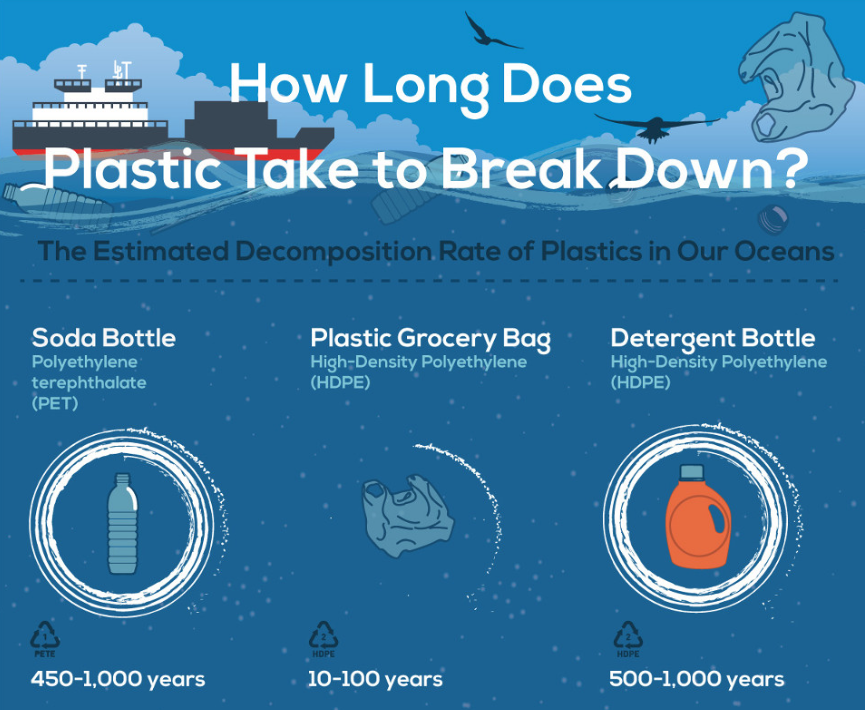 Each time we pack purchases in free plastic bags (or even buy them). Let's calculate. It turns out that during the year we bring home about 160 packages, and if we take into account those packages in which fruits, vegetables, meat (double package), fish (double package), pickled vegetables (double package) are packed. It's hard to even calculate how much each of us can use cellophane and plastic!
Each time we pack purchases in free plastic bags (or even buy them). Let's calculate. It turns out that during the year we bring home about 160 packages, and if we take into account those packages in which fruits, vegetables, meat (double package), fish (double package), pickled vegetables (double package) are packed. It's hard to even calculate how much each of us can use cellophane and plastic!
Let's take the average inhabitant of the planet Earth at the present time. So, the average resident:
How to minimize the use of plastic packaging in our lives?
What can each of us, the inhabitants of our beautiful planet Earth, do to make a conscious contribution to solving this problem?
There are a few simple steps:
1. Use reusable bags made of natural materials to visit shops and supermarkets, buy groceries and other goods! Canvas, fabric, baskets, string bags! It's beautiful, and most importantly, very comfortable.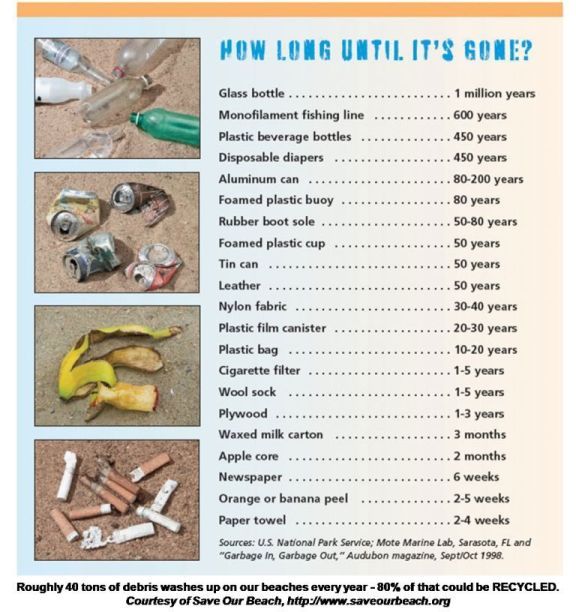 You can go shopping with them an infinite number of times! 🙂
You can go shopping with them an infinite number of times! 🙂
And also, using an ecological bag, you do not use from 6 plastic bags per week and from 300 per year!
2. Stop using plastic bags that come free with purchases in stores. If we start to refuse cellophane in stores, the demand for them will fall. So, in the near future, where demand falls, supply will also fall. And if people stop consuming, it will stop and be produced!
Example. One inhabitant of the Earth, refusing plastic during the year, does not use 50 liters of oil, which means that the number of oil developments is reduced, the risk of pollution of our nature by oil spills is reduced!
3. If you use plastic, find a way to recycle it. As we found out, other people will not be able to do it for you anyway. It turns out that by throwing away plastic, you take responsibility for this non-recyclable garbage on yourself.
How can plastic be recycled?
Keep using it. Go shopping with the same plastic bags, then wash and reuse.
Go shopping with the same plastic bags, then wash and reuse.
Read materials on the Internet about how people came up with a lot of creative crafts from cellophane, polyethylene and plastic bottles. For example, many knit bags, baskets, bath mats, slippers and slippers from cellophane. From plastic bottles, you can make completely different crafts - feeders, flowers, butterflies, and more. You can read about it in our next articles. 🙂
If you already have a similar experience with plastic disposal or recycling, write to us about it! And also write in the comments how to solve the issue of plastic packaging in our daily life?
The ecology of life is in our hands. Thank you for your attention. Have a good day.
Mother Earth and lamenting over this, it is worth mentioning one of the main causes of the hidden danger - long-term, in most cases accompanied by the release of toxic substances. Let's jump ahead a bit and see what awaits our descendants who have decided to explore the soil profiles of urban horizons.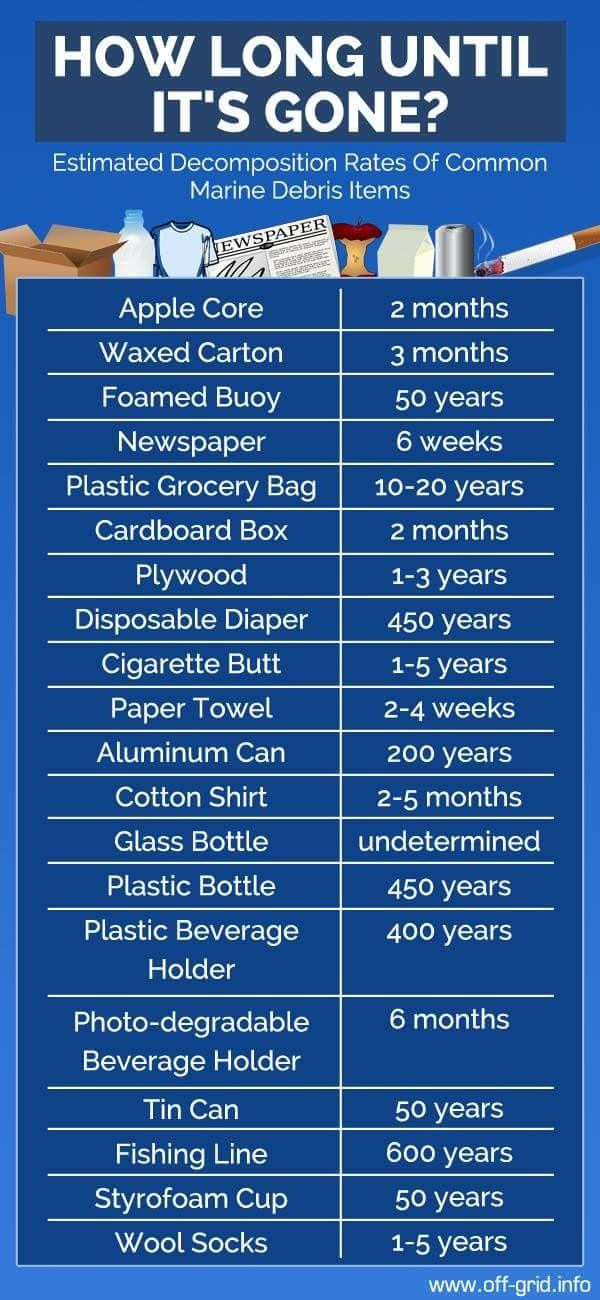
We remember that in nature, therefore, we will not find garbage remains of natural origin (vegetable or animal), because they decompose the fastest.
So, animal droppings (valuable, by the way) decomposes in a maximum of 10 days.
But fallen leaves, small twigs, will gradually rot, turning into a humus mass in a month or a whole season.
Large branches take longer to decompose, but after a maximum of 10 years there will be no trace left of them.
Banana peel - neither less nor more, and the decomposition period is up to 6 months, so throw it under the nearest bush, with the thought: “It will rot soon!” not worth it.
The ubiquitous microorganisms are processed on average in a few weeks.
But remains of bones can lie for 5 or 6 years, but, in general, no more than 8.
Clothing from decomposes in 2-3 years, while not causing damage to the environment, which cannot be said about synthetic materials, whose decomposition period is up to 40 years.
But woolen goods is much more, since it takes only a year to “digest” them.
Paper decomposition time vary. So, a discarded trolleybus ticket will completely disappear from the face of the Earth in just a month. decomposes in 2-3 years, and wax paper - as much as 5 years. By the way, it is strictly forbidden to burn paper together with food, as this can result in the formation of dioxides.
Wood products decompose for up to 10 years. However, the degree of wood processing plays a significant role in this process. So, if ordinary boards decompose in 4 years, then coated with a layer of paint - already for 13.
Bank - one of the most popular. Do you know how long it takes for these containers, often disposable, to decay? Iron cans required up to 10 years, tin - about 90, but aluminum - about 500. Only 5 centuries, nothing compared to eternity :).
What else to remember? Oh yes. The ubiquitous polyethylene. So, the time of decomposition of products from this material depends on the initial density and structure. For example, ordinary thin plastic bags , in which sellers love to wrap everything so much, decompose for 100-200 years. They are accompanied by "partners" - and containers.
The ubiquitous polyethylene. So, the time of decomposition of products from this material depends on the initial density and structure. For example, ordinary thin plastic bags , in which sellers love to wrap everything so much, decompose for 100-200 years. They are accompanied by "partners" - and containers.
Small filter carelessly discarded cigarette butt b will slowly lose ground, decomposing over 3 years.
Ordinary ones, which are recommended to be changed at least once a week due to the development of microorganisms, after seven days of hard work go to a well-deserved rest. True, it comes only within the next 200 years.
Tires are one of the main and most obvious "consumables" of any car. At the same time, there are more than 42 million cars in Russia alone. With trucks and special equipment - about 59.7 million. This means that at least a million tons of used car tires are thrown into landfills every year. In this context, it is no longer a means of ensuring contact with the surface, but simply hazardous waste.
In this context, it is no longer a means of ensuring contact with the surface, but simply hazardous waste.
Formally, automobile tires belong to IV hazard class waste, that is, low-hazard waste. But do not underestimate their danger - improperly disposed tires cause significant damage to the environment.
Under natural conditions, a discarded or buried tire takes hundreds of years to decompose. Upon contact with moisture, toxic organic compounds are washed out of them. Tires partially filled with water become breeding grounds for rats and blood-sucking insects. Millions of tires thrown into landfills are an environmental disaster in itself, even without taking into account the area occupied, therefore, over a good hundred years, mankind has developed several ways to dispose of this type of waste.
The first method involves the use of whole car tires - for example, to protect slopes from erosion, soundproof barriers along highways, and safety barriers for auto racing tracks. In the seventies of the last century, even artificial reefs were made from used tires! So, in 1972, the so-called Osborne Reef was created off the coast of Florida by the BARINC (Broward Artificial Reef) group with the support of Goodyear. More than two million tires were sunk to create breeding grounds for fish and oysters. The effect, unfortunately, turned out to be the opposite - the steel straps that fix the tires quickly rotted. Tires began to be thrown onto the beaches, they began to destroy neighboring coral reefs. For the last fifteen years, tires have been taken back - including with the use of army divers.
In the seventies of the last century, even artificial reefs were made from used tires! So, in 1972, the so-called Osborne Reef was created off the coast of Florida by the BARINC (Broward Artificial Reef) group with the support of Goodyear. More than two million tires were sunk to create breeding grounds for fish and oysters. The effect, unfortunately, turned out to be the opposite - the steel straps that fix the tires quickly rotted. Tires began to be thrown onto the beaches, they began to destroy neighboring coral reefs. For the last fifteen years, tires have been taken back - including with the use of army divers.
The second popular way to dispose of tires is incineration (including for energy purposes). In most cases, it is such disposal that causes maximum damage to nature and human health. The fact is that during combustion, not only zinc and sulfur oxides are emitted into the atmosphere, but also dioxins, which are classified as superecotoxicants of the 1st hazard class.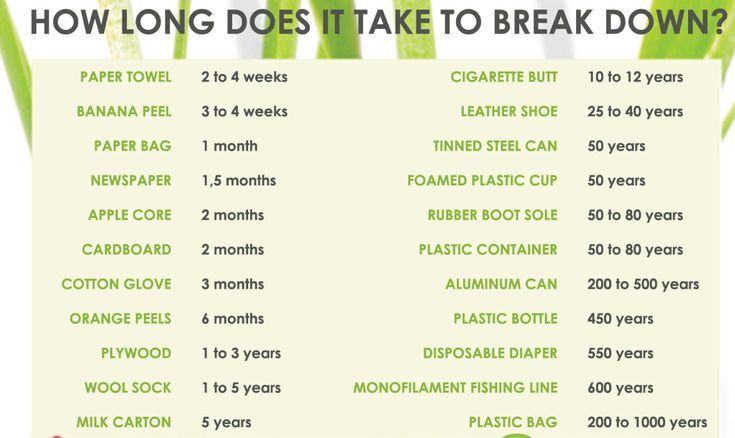 These substances have mutagenic, carcinogenic and cumulative properties. In terms of toxicity, dioxins surpass almost any known poison, and, moreover, they do not decompose for decades, accumulating in the upper soil layer, as well as in all environmental objects, including plants and animals.
These substances have mutagenic, carcinogenic and cumulative properties. In terms of toxicity, dioxins surpass almost any known poison, and, moreover, they do not decompose for decades, accumulating in the upper soil layer, as well as in all environmental objects, including plants and animals.
Burning tires in high-temperature (1200-2800 degrees Celsius) kilns of modern cement or pulp and paper plants is also not a panacea - according to many experts, this method of disposal also releases dioxins into the atmosphere, albeit to a lesser extent. Installing highly efficient cleaning systems to trap harmful gases makes burning tires for energy unprofitable.
Another method of recycling used tires is pyrolysis. Tires are loaded into special reactors, where at high temperature in the absence of oxygen the product decomposes into components (carbon black, pyrolysis gas, as well as liquid fractions suitable for use as heating oil). The gas released during the process can also be used to produce fuel.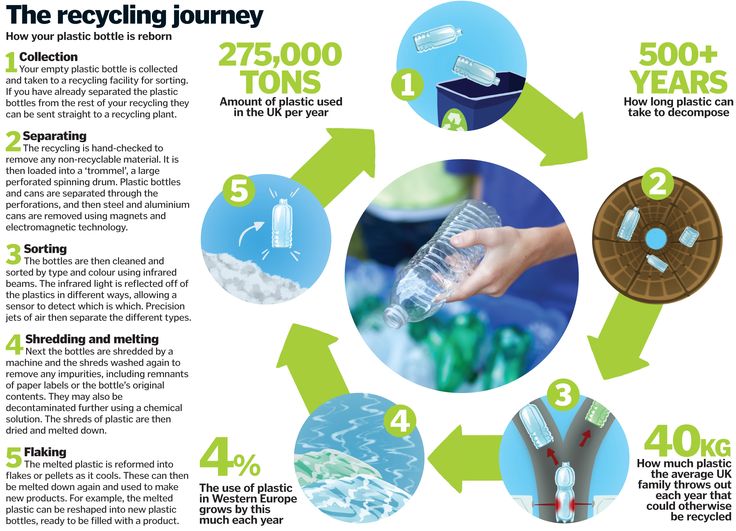 This technology is demanding on equipment, and until recently was considered insufficiently effective. However, modern pyrolysis plants are already devoid of such shortcomings.
This technology is demanding on equipment, and until recently was considered insufficiently effective. However, modern pyrolysis plants are already devoid of such shortcomings.
The most cost-effective is the mechanical grinding of tires. When using this method, rubber and other polymers that make up the tire are obtained in the form of dispersed materials. The resulting crumb rubber takes on a new life in the form of various rubber products, such as car mats, speed bumps, playground surfaces, and so on. The most finely dispersed rubber crumb is used as an additive (from 5 to 20%) in the rubber compound in the production of new tires. There are several ways to mechanically shred tires based on different physical principles, such as using high impact velocities, low temperatures, or high pressures.
Despite the fact that in Russia today there are at least several large and a large number of small plants for recycling car tires using one of the listed industrial methods, these industries are far from being fully loaded. The reason is simple - most tires are disposed of in a simple and illegal way - throwing them into a landfill or burning them.
The reason is simple - most tires are disposed of in a simple and illegal way - throwing them into a landfill or burning them.
That's why the correct disposal and recycling of tires is one of the most important priorities for protecting human health and the environment. A new project from Nokian Tires, the Nokian Eco Challenge, serves this very purpose. As part of the project, the company assumes obligations to eliminate illegal tire dumps.
The mechanics is simple - anyone can submit an application for the liquidation of a landfill, on their own behalf or from an organization. As part of the project, tire dumps with a volume of at least 10 tons are eliminated, which, in terms of tires, is about 250 truck or 1,000 passenger tires. All collected tires will be recycled.
By the way, the Yaroslavl authorities came up with a similar initiative almost simultaneously. So, at the Skokovo landfill near Yaroslavl, a plant for crushing waste and recycling old tires is to be built this year.